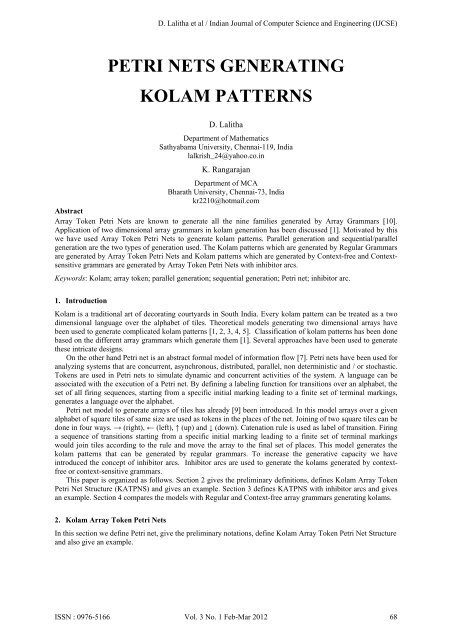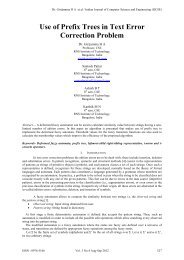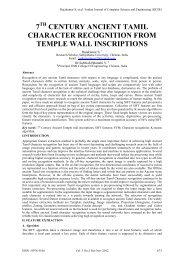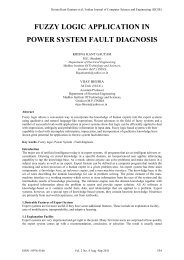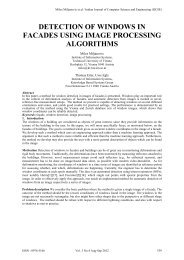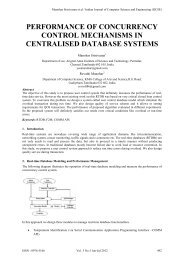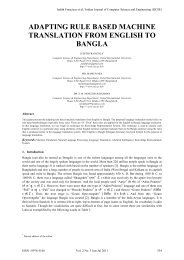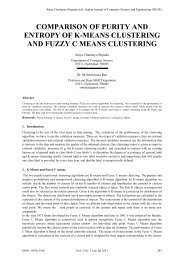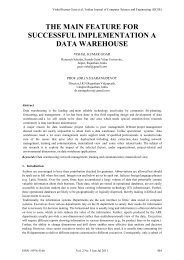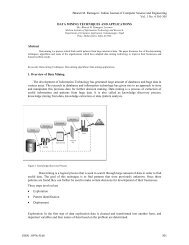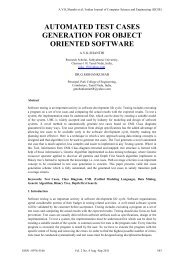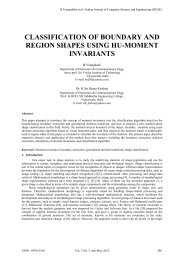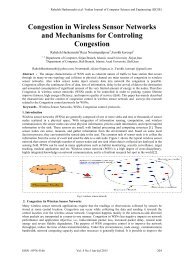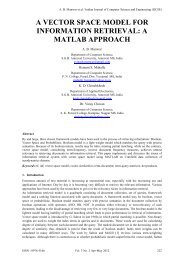petri nets generating kolam patterns - Indian Journal of Computer ...
petri nets generating kolam patterns - Indian Journal of Computer ...
petri nets generating kolam patterns - Indian Journal of Computer ...
You also want an ePaper? Increase the reach of your titles
YUMPU automatically turns print PDFs into web optimized ePapers that Google loves.
D. Lalitha et al / <strong>Indian</strong> <strong>Journal</strong> <strong>of</strong> <strong>Computer</strong> Science and Engineering (IJCSE)PETRI NETS GENERATINGKOLAM PATTERNSD. LalithaDepartment <strong>of</strong> MathematicsSathyabama University, Chennai-119, Indialalkrish_24@yahoo.co.inK. RangarajanDepartment <strong>of</strong> MCABharath University, Chennai-73, Indiakr2210@hotmail.comAbstractArray Token Petri Nets are known to generate all the nine families generated by Array Grammars [10].Application <strong>of</strong> two dimensional array grammars in <strong>kolam</strong> generation has been discussed [1]. Motivated by thiswe have used Array Token Petri Nets to generate <strong>kolam</strong> <strong>patterns</strong>. Parallel generation and sequential/parallelgeneration are the two types <strong>of</strong> generation used. The Kolam <strong>patterns</strong> which are generated by Regular Grammarsare generated by Array Token Petri Nets and Kolam <strong>patterns</strong> which are generated by Context-free and Contextsensitivegrammars are generated by Array Token Petri Nets with inhibitor arcs.Keywords: Kolam; array token; parallel generation; sequential generation; Petri net; inhibitor arc.1. IntroductionKolam is a traditional art <strong>of</strong> decorating courtyards in South India. Every <strong>kolam</strong> pattern can be treated as a twodimensional language over the alphabet <strong>of</strong> tiles. Theoretical models <strong>generating</strong> two dimensional arrays havebeen used to generate complicated <strong>kolam</strong> <strong>patterns</strong> [1, 2, 3, 4, 5]. Classification <strong>of</strong> <strong>kolam</strong> <strong>patterns</strong> has been donebased on the different array grammars which generate them [1]. Several approaches have been used to generatethese intricate designs.On the other hand Petri net is an abstract formal model <strong>of</strong> information flow [7]. Petri <strong>nets</strong> have been used foranalyzing systems that are concurrent, asynchronous, distributed, parallel, non deterministic and / or stochastic.Tokens are used in Petri <strong>nets</strong> to simulate dynamic and concurrent activities <strong>of</strong> the system. A language can beassociated with the execution <strong>of</strong> a Petri net. By defining a labeling function for transitions over an alphabet, theset <strong>of</strong> all firing sequences, starting from a specific initial marking leading to a finite set <strong>of</strong> terminal markings,generates a language over the alphabet.Petri net model to generate arrays <strong>of</strong> tiles has already [9] been introduced. In this model arrays over a givenalphabet <strong>of</strong> square tiles <strong>of</strong> same size are used as tokens in the places <strong>of</strong> the net. Joining <strong>of</strong> two square tiles can bedone in four ways. → (right), ← (left), ↑ (up) and ↓ (down). Catenation rule is used as label <strong>of</strong> transition. Firinga sequence <strong>of</strong> transitions starting from a specific initial marking leading to a finite set <strong>of</strong> terminal markingswould join tiles according to the rule and move the array to the final set <strong>of</strong> places. This model generates the<strong>kolam</strong> <strong>patterns</strong> that can be generated by regular grammars. To increase the generative capacity we haveintroduced the concept <strong>of</strong> inhibitor arcs. Inhibitor arcs are used to generate the <strong>kolam</strong>s generated by contextfreeor context-sensitive grammars.This paper is organized as follows. Section 2 gives the preliminary definitions, defines Kolam Array TokenPetri Net Structure (KATPNS) and gives an example. Section 3 defines KATPNS with inhibitor arcs and givesan example. Section 4 compares the models with Regular and Context-free array grammars <strong>generating</strong> <strong>kolam</strong>s.2. Kolam Array Token Petri NetsIn this section we define Petri net, give the preliminary notations, define Kolam Array Token Petri Net Structureand also give an example.ISSN : 0976-5166 Vol. 3 No. 1 Feb-Mar 2012 68
D. Lalitha et al / <strong>Indian</strong> <strong>Journal</strong> <strong>of</strong> <strong>Computer</strong> Science and Engineering (IJCSE)Definition 1. A Petri Net structure is a four tuple C = (P,T,I,O) where P = {p 1 , p 2 ,....., p n } is a finite set <strong>of</strong>places, n ≥ 0, T = {t 1, t 2, …, t m } is a finite set <strong>of</strong> transitions m ≥ 0, P∩T= Ø, I:T→P ∞ is the input function fromtransitions to bags <strong>of</strong> places and O:T→P ∞ is the output function from transitions to bags <strong>of</strong> places.Definition 2. A Petri Net marking is an assignment <strong>of</strong> tokens to the places <strong>of</strong> a Petri Net. The tokens are used todefine the execution <strong>of</strong> a Petri Net .The number and position <strong>of</strong> tokens may change during the execution <strong>of</strong> aPetri Net.Definition 3. An inhibitor arc from a place p i to a transition t j has a small circle in the place <strong>of</strong> an arrow inregular arcs. This means the transition t j is enabled only if p i has no tokens. A transition is enabled only if all itsregular inputs have tokens and all its inhibitor inputs have zero tokens.To generate <strong>kolam</strong>s we use alphabets consisting <strong>of</strong> square tiles <strong>of</strong> same size with <strong>patterns</strong> in it. A certainfamily <strong>of</strong> <strong>patterns</strong> called ‘Kambi Kolam’ over a square grid, is expressed with regular dotted square tiles. Nagataet al [8] have given a digital representation to such tiles. The set <strong>of</strong> primitives given below are primitives used in<strong>generating</strong> ‘Kambi Kolam’ [8].DiamondDPupilp 1 p 2Dropd 1 d 2 d 3 d 4f 1 f 4f 2f 3FanS 4Saddlefig 1S 1 S 2 S 32fig 2We denote a square tile without any pattern by B (blank). Arrays over the alphabet <strong>of</strong> tiles will form a pattern.B d4BFor example the array d3D d1with the alphabet taken from fig 1, will form the <strong>kolam</strong> in fig 2.B d BIn this model arrays over the alphabet <strong>of</strong> tiles is used as tokens in places. If all the input places <strong>of</strong> a transitionhave the same array as tokens then firing the transition moves the array from the input place to its output place.If all the input places <strong>of</strong> a transition have different arrays or if one input place has different arrays then thetransition without label cannot fire. Two types <strong>of</strong> labels are used in this model.I. Name <strong>of</strong> an input place:If the transition has many input places with different arrays as tokens then the label specifiesan input place which has sufficient number <strong>of</strong> tokens <strong>of</strong> the same array. Then firing the transition will removetokens from all its regular input places and the array which is in the (label specified) place will be moved intothe output place. An example <strong>of</strong> this is given in fig 3.ISSN : 0976-5166 Vol. 3 No. 1 Feb-Mar 2012 69
D. Lalitha et al / <strong>Indian</strong> <strong>Journal</strong> <strong>of</strong> <strong>Computer</strong> Science and Engineering (IJCSE)Position <strong>of</strong> tokens before firing:P 1A t 1 (p 1 )3P 2Position <strong>of</strong> tokens after firing:A 1 , A 2 P 3P 1t 1 (p 1 )A 3P 2Afig 3II. Catenation rule:If T is a transition <strong>of</strong> a net then the label σ(T) is a set <strong>of</strong> catenation rules. When any catenation rule is used as alabel <strong>of</strong> a transition, all the input places <strong>of</strong> the transition should have the same array as token. A transition withinput places having different arrays and a catenation rule as label cannot fire.Catenation <strong>of</strong> tiles or joining <strong>of</strong> tiles can be done in four directions → (right), ← (left), ↑ (up) and ↓ (down). ForA, D Σ ** the four catenation rules are given below.A→D joins D to the right <strong>of</strong> A so that right side <strong>of</strong> A and left side <strong>of</strong> D coincide.A← D joins D to the left <strong>of</strong> A so that the left side <strong>of</strong> A and right side <strong>of</strong> D coincide.In the above two cases A and D should have the same number <strong>of</strong> rows.A ↑ D joins D above A so that the top <strong>of</strong> A and bottom <strong>of</strong> D coincide.A ↓ D joins D below A so that the bottom <strong>of</strong> A and top <strong>of</strong> D coincide.In the above two cases A and D should have the same number <strong>of</strong> columns.In applying catenation rules two types <strong>of</strong> generations are considered (i) Parallel and (ii) Sequential/ Parallel.Parallel generation: Rules are applied in a parallel manner in this generation. If A→D is the rule applied thenall A in the last column will be joined to D in the right. If a right rule → is used as a label all the tiles in the lastcolumn <strong>of</strong> the array in the input place will have to be catenated with some tile in the alphabet. If a rule ismissing for any <strong>of</strong> the tile, then a blank tile will be joined to the specific tile. For example let the input place <strong>of</strong> aX D Xtransition T have the array D D D and σ(T) = { X →X, D→X }. In parallel generation all X on the lastX D Xcolumn will be catenated to X and D is catenated to X. Hence firing the transition will join X to the right <strong>of</strong> allX D X Xtiles <strong>of</strong> the array. The resultant array reaching the output place would be D D D X .X D X XIf σ(t) = { X →X}then firing the transition will join X to the right <strong>of</strong> all X and a blank tile B to the right <strong>of</strong> D.X D X XThe resultant array reaching the output place would be D D D B . Similarly in all other three rules weX D X Xapply the rules in a parallel manner and missing rule is automatically joined to B in the specified direction.Sequential/ Parallel generationIn <strong>kolam</strong> <strong>patterns</strong> we find two kinds <strong>of</strong> pullis used. One is rectangular and the other is in the form <strong>of</strong>diamond or triangular. Hence parallel generation may not be able to generate all <strong>kolam</strong>s. Hence we useSequential/ Parallel generation.Column Rule: In case all X in the last column (first column) <strong>of</strong> the array is not required to be joined to X usingright rule (left rule). If the topmost(tm) X and bottommost(bm) X is to be joined to a blank tile then we use thenotation tmX→B (tmX←B), bmX→B (bmX←B). Except the first X and the last X <strong>of</strong> the column all the otherX are catenated to X in a parallel manner. For example let the input place <strong>of</strong> a transition T have theX X Xarray X D X .X X XP 3ISSN : 0976-5166 Vol. 3 No. 1 Feb-Mar 2012 70
D. Lalitha et al / <strong>Indian</strong> <strong>Journal</strong> <strong>of</strong> <strong>Computer</strong> Science and Engineering (IJCSE)XIf σ(T)={X →X, tmX→B, bmX→B }. The resultant array reaching the output place would be XXDXXBX .X X X BRow Rule:In case all X in the first row (last row) <strong>of</strong> the array is not required to be joined to X using up rule (down rule). Ifthe leftmost(lm) X and rightmost(rm) X is to be joined to a blank tile then we use the notation lmX↑B (lmX↓ B),rmX↑B (rmX↓ B). Except the first X and the last X <strong>of</strong> the row all the other X are catenated to X in a parallelXmanner. For example let the input place <strong>of</strong> a transition T have the array XXDXX .X X XBIf σ(T)={ lmX↑B, rmX↑B, X ↑X, }. The resultant array reaching the output place would beXXXFor example consider the net in the following figureXXDXBX.XXP 1t 1P 2At 2P 3If A =XXXXDXYreaches the place p 2 is YYXX , σ(t 1 ) = {X ←Y} and σ(t 2 ) = { lmX↑B, rmX↑B, X ↑X, } then after firing t 1 the array thatXXXXXDXXX . All X in the first column is joined to y in the left. Once this array reachesXB B X Bp 2 the transition t 2 is enabled and so when t 2 fires the array that reaches p 3 will beY X X X. The left mostY X D XY X X X<strong>of</strong> X and the right most <strong>of</strong> X are joined to a blank tile and the middle X is joined to X. Since no rule is given forY it is being joined with a blank tile. All these catenations are done in the upward direction. In general all rulesare applied in a parallel manner unless the prefix rm, lm, tm and bm is used along with a rule. Hence we call itsequential/parallel generation.Definition 4. A Kolam Array Token Petri Net Structure (KATPNS) is a four tuple (C, Σ, σ, F) whereC = (P, T, I, O) is a Petri net structure, Σ an alphabet <strong>of</strong> square tiles <strong>of</strong> same size, σ partial function on the set <strong>of</strong>transitions which define the labels, M 0 :P→Σ ** is the initial marking and F ⊆ P is a set <strong>of</strong> final places.Definition 5. The language generated by the KATPNS is L(C) = {A Σ ** / A is in p for some p in F}. Witharrays <strong>of</strong> Σ ** in some places as initial marking all possible sequences <strong>of</strong> transitions are fired. The set <strong>of</strong> all arrayscollected in the final places F is called the language generated by C.Example 1. The KATPNS (C, Σ, σ, F) where the graph <strong>of</strong> C is given in fig 6, Σ ={X, T, R, D, L, C 1 , C 2 ,C 3 , C 4 },σ the partial function is given in fig 5, S = X is the initial marking in p 1 and p 3 and F = {p 2 }. The generation hereis parallel. The tiles are given in fig 4. The arrays reaching p 2 are collected as the language generated.C 1C 2C 3C 4TRLDXfig 4ISSN : 0976-5166 Vol. 3 No. 1 Feb-Mar 2012 71
D. Lalitha et al / <strong>Indian</strong> <strong>Journal</strong> <strong>of</strong> <strong>Computer</strong> Science and Engineering (IJCSE)σ(t 2 ) = { X↑X},σ(t 3 ) = { X→ X},σ(t 4 )= { X↑T},σ(t 5 ) ={ X↓D}σ(t 6 ) ={ T →C 1 , X→R,D→C 4 },σ(t 7 ) = { T← C 2 , X←L,D←C 3 },p 1 S t 2p 4 tt 51 (p 1 )t 4Spp 53p 2 t 6t 3t 7fig 5 fig 6The firing sequence t 4 t 5 t 6 t 7 generates the <strong>kolam</strong> referred to as ‘”Asanapalakai” is given in fig 7.CC2L3TXDCC1R4fig 7Transitions t 2 and t 3 can be fired any number <strong>of</strong> times before we fire t 4. Firing t 2 and t 3 generates an array madeup <strong>of</strong> the tile X. Then when the sequence t 4 t 5 t 6 t 7 is fired we get all the boundary tiles. This <strong>kolam</strong> pattern canbe generated by a Regular Matrix Grammar [1] and has used only parallel generation.3. KATPNS with inhibitor arcsIn this section we define KATPNS with inhibitor arcs and give example. When parallel generation is used wecan generate only rectangular pictures. To generate triangular or diamond shaped <strong>kolam</strong>s we have to use inSequential/ Parallel generation. To generate Kolams generated by Context-free or Context-sensitive grammarwe have to control the sequence <strong>of</strong> firing. This control is achieved by introducing inhibitor arcs in the Petri net.Definition 6. If the Petri net C <strong>of</strong> a KATPNS has at least one inhibitor arc then we define the KATPNS asKolam Array Token Petri Net Structure with inhibitor arcs. With arrays <strong>of</strong> Σ ** in some places as initial markingall possible sequences <strong>of</strong> transitions are fired. The set <strong>of</strong> all arrays collected in the final places F is called thelanguage generated by C.Example 2. The KATPNS (C, Σ, σ, F) where the graph <strong>of</strong> C is given in fig 8, Σ ={ D, S 1 , S 2 , S 3 , S 4 , d 2 , d 4 }, σthe partial function is given in fig 9, the initial marking S in p 1 and p 3 and F = {p 2 }. The generation here issequential/parallel. The tiles are given in fig 1.ISSN : 0976-5166 Vol. 3 No. 1 Feb-Mar 2012 72
D. Lalitha et al / <strong>Indian</strong> <strong>Journal</strong> <strong>of</strong> <strong>Computer</strong> Science and Engineering (IJCSE)t 1 (p 1 )p 5p 4p S 1t 4 (p 6 )t 2Sp 3p 2t 7 (p 8 )t p 6 3p 9p 8t 6t 5p 7t 9t 8t 11 p 11t 10 p 10D σ(t 2 ) = { D↑ D },S = DD σ(t 5 ) = { tm D→ S 1 , bm D→S 2 , D→D},σ(t 6 )= σ(t 5 )σ(t 8 ) = { tm D← S 4 , bm D←S 3 , D←D},σ(t 9 ) = σ(t 9 )σ(t 10 ) = { D↑d 4 }σ(t 11 ) = { D↓d 2 }fig 9fig 8The firing sequence t 2 t 3 t 4 t 5 t 6 t 7 t 8 t 9 t 10 t 11 generates the Kolam pattern in fig 10. To start with t 2 and t 3 are bothenabled. If t 2 is fired then the inhibitor input p 4 <strong>of</strong> t 6 makes sure that the sequence t 4 t 5 is also fired the samenumber <strong>of</strong> times. Similarly the inhibitor input p 5 <strong>of</strong> t 9 makes sure that the sequence t 7 t 8 is also fired the samenumber <strong>of</strong> times. The Kolam <strong>patterns</strong> generated are <strong>of</strong> size (2n + 4) x (2n +3)/ n ≥ 0, where n is the number <strong>of</strong>times t 2 is fired. This <strong>kolam</strong> is context-sensitive [5].Fig 10: Kambi <strong>kolam</strong>4. Comparative ResultsIn this section we recall the definitions <strong>of</strong> Array rewriting Grammar [6], compare KATPNS and KATPNSwith inhibitor arcs with some <strong>of</strong> the Kolam array grammars.Definition 6: G = ( V, I, , S ) is an array rewriting grammar(AG), where V = V 1 V 2 , V 1 a finite set <strong>of</strong>nonterminals, V 2 a finite set <strong>of</strong> intermediates, I a finite set <strong>of</strong> terminals, P = P 1 P 2 P 3 , P 1 is the finite set <strong>of</strong>nonterminal rules, P 2 is the finite set <strong>of</strong> intermediate rules, P 3 is the finite set <strong>of</strong> terminal rules. S V 1 is the startsymbol. P 1 is a finite set <strong>of</strong> ordered pairs (u, v), u and v in (V 1 V 2 ) + or u and v in (V 1 V 2 ) +.P 1 is context-sensitive if there is a (u,v) in P 1 such that u = u 1 S 1 v 1 and v = u 1 α v 1 where S 1 V 1 , u 1 , α, v 1 areall in (V 1 V 2 ) + or all in (V 1 V 2 ) +. P 1 is context-free if every (u,v) in P 1 is such that uV 1 and v in (V 1 V 2 ) + or (V 1 V 2 ) +. P 1 is regular if u V 1 and v <strong>of</strong> the form U V, U inV 1 and V in V 2 or U in V 2 and V inV 1 .P 2 is a set <strong>of</strong> ordered pairs (u,v), u and v in (V 2 {x 1 ,…,x p }) + or u and v in (V 2 {x 1 ,…,x p }) + ;x 1 ,…,x p in I ++ have same number <strong>of</strong> rows in the first case and same number <strong>of</strong> columns in the second case. P 2 iscalled CS, CF or R as the intermediate matrix languages generated are CS, CF or R.P 3 is a finite set <strong>of</strong> terminal rules are ordered pairs (u,v), u in (V 1 V 2 ) and v in I ++ .An Array Grammar is called (CS:CS)AG if the nonterminal rules are CS and at least one intermediate languageis CS. An Array Grammar is called (CS:CF)AG if the nonterminal rules are CS and none <strong>of</strong> the intermediateISSN : 0976-5166 Vol. 3 No. 1 Feb-Mar 2012 73
D. Lalitha et al / <strong>Indian</strong> <strong>Journal</strong> <strong>of</strong> <strong>Computer</strong> Science and Engineering (IJCSE)language is CS. An Array Grammar is called (CS:R)AG if the nonterminal rules are CS and all the intermediatelanguages are regular. Similarly all the other six families (CF:CS)AG, (CF:CF)AG, (CF:R)AG, (R:CS)AG,(R:CF)AG and (R:R)AG are defined. (X:Y)AL refers to the language generated by the (X:Y)AG, where X, Y{ R, CF,CS}.Theorem 4.1. Any Regular Matrix <strong>kolam</strong> can be generated by KATPNS.Pro<strong>of</strong>. If the pattern is generated by a regular matrix grammar then it can be generated by (R:R)AG. Any regulararray grammar can be generated by a Array Token Petri Net Structure (ATPNS) without inhibitor arcs [10]. Thesequence <strong>of</strong> firing in a KATPNS without inhibitor arcs is in the form (t 1nt jm) k . Thus we do not require inhibitorarc to generate this <strong>kolam</strong> pattern.Theorem 4.2. Any (CF:R) array <strong>kolam</strong> can be generated by KATPNS with inhibitor arcs.nPro<strong>of</strong>. The non terminal rules <strong>of</strong> (CF:R) array grammar are in the formn ( A)n( A ) ( B)or . Have a subnet to( B)ngenerate (A) n and another to generate (B) n . Use inhibitor arcs to make sure both the sub<strong>nets</strong> are executed thesame number <strong>of</strong> times. In example 2, the number <strong>of</strong> times the sequences t 2 , t 4 t 5 and t 7 t 8 are fired is beingcontrolled by the introduction <strong>of</strong> the two inhibitor arcs. We can restrict the firing <strong>of</strong> a transition by introducingan inhibitor arc. Thus (CF:R) array <strong>kolam</strong> can be generated by KATPNS with inhibitor arcs.5. ConclusionInteresting <strong>kolam</strong> <strong>patterns</strong> are described by Array grammars. Since Array Token Petri Net Structure is able togenerate all these families we have tried to generate <strong>kolam</strong> <strong>patterns</strong> with Petri net. KATPNS is able to generateall regular <strong>kolam</strong>s and with the introduction <strong>of</strong> inhibitor arcs the (CF:R) <strong>kolam</strong> <strong>patterns</strong> are also generated.References[1] G. Siromoney, R. Siromoney and Kamala Krithivasan, Array Grammars and Kolam, <strong>Computer</strong> Graphics and Image Processing 3,1974, pp63 - 82.[2] G. Siromoney, R. Siromoney and Kamala Krithivasan, Abstract families <strong>of</strong> Matrices and Picture Languages , <strong>Computer</strong> Graphics andImage Processing 1, 1972, pp 284 – 307.[3] K.G.Subramanian, A Note on Regular Kolam Array Grammars Generating Right Triangles, Pattern Recognition Vol. 11, 1979, pp343 – 345.[4] K.G. Subramanianan, Rosihan M. Ali, M. Geethalakshmi, Atulya K. Nagar, Pure 2D Picture Grammars And Languages, DiscreteApplied Mathematics,157(2009) 3401_3411.[5] G. Siromoney, R. Siromoney and T. Robinson, “Kambi <strong>kolam</strong> and cycle grammars”, A Perspective in theoretical computer science,16, 1989, pp 267-300.[6] G. Siromoney, R. Siromoney and Kamala Krithivasan, Picture Languages with Array Rewriting Rules, Information and Control 22, pp447 - 470, 1973.[7] J .L Peterson, Petri Net Theory an Modeling systems, Prentice Hall, Inc., Englewood Cliffs, N J , 1981.[8] Shojiro Nagata , Robinson Thamburaj, “ Digitalization Of Kolam Patterns And Tactile Kolam Tools”, Formal Models, Languages AndApplications, World Scientific, pp 354-363.[9] D. Lalitha and K. Rangarajan, “Characterisation Of Pasting System Using Array Token Petri Nets”. International <strong>Journal</strong> <strong>of</strong> Pure andApplied Mathematics, Vol 70, No. 3, 2011.[10] D. Lalitha, K. Rangarajan and D.G. Thomas, “Rectangular Arrays and Petri Nets”, Proceedings <strong>of</strong> National Conference on Theoretical<strong>Computer</strong> Science and Discrete Mathematics, Kalasalingam University, Jan 2012.ISSN : 0976-5166 Vol. 3 No. 1 Feb-Mar 2012 74


